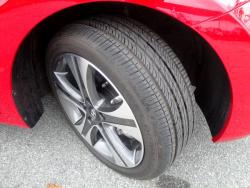 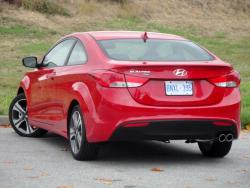 2013 Hyundai Elantra Coupe SE. Click image to enlarge |
The Elantra Coupe’s performance could be described as adequate but not exciting: with the automatic transmission, its 0 to 100 km/h is estimated is 9.6 seconds vs 10 seconds for the Civic Coupe automatic, according to Automobile-catalog.com—that’s one to two seconds slower than the Scion tC and Forte Koup SX. The Elantra’s four-cylinder engine lets out a muted buzz under acceleration but it’s not particularly noisy and it’s reasonably quiet at highway speeds where it turns over just 2,000 rpm at a steady 100 km/h. The six-speed automatic changes up and down unobtrusively and can be shifted manually using the sequential manual shift pattern—push forward to shift up, pull back to shift down.
The Coupe’s handling is flat and steady with the SE’s 17-inch tires—our car was equipped with Hankook Optimo 215/45R 17-inch all-seasons which provided good grip in dry and wet pavement conditions and proved reasonably quiet at highway speeds. The Elantra’s suspension consists of front MacPherson struts with coil springs and a rear semi-independent torsion beam with gas shocks and coil springs. That and a 2,700-mm wheelbase (80 mm longer than the Civic Coupe) contribute to a fairly comfortable ride without the choppiness found in shorter wheelbase coupes. With its low-revving top gear and compliant ride, the Elantra Coupe is quite a comfortable highway cruiser.
Steering effort is light, turn-in responsiveness is good, and its power rack-and-pinion steering offers a reasonably tight 10.6-metre (34.8-ft) turning circle. The driver’s visibility is quite good, helped by the long rear side windows, which aid visibility when changing lanes. Still, like other sporty coupes that have a high rear deck, rearward visibility is compromised, and there is no rear wiper. Only the Scion tC offers one in this class. However, the Elantra Coupe SE’s rear-view camera certainly helps when backing into a parking space.
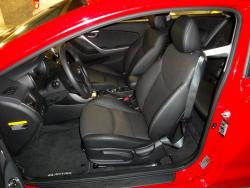 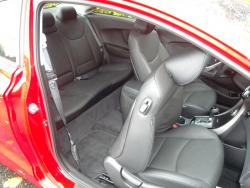 > 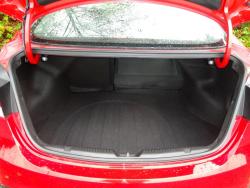 2013 Hyundai Elantra Coupe SE. Click image to enlarge |
Being a fairly lightweight car (1,305 kg) with beefy 17-inch tires, four disc brakes, ABS, and stability control, the Elantra Coupe stops quickly and pedal feel is firm.
While compact coupes typically sacrifice practicality for style, the Elantra Coupe is more practical than most. Like its competitors, it’s a five-passenger coupe, but its passenger volume of 2,701 L is significantly roomier: it compares to the Civic Coupe’s 2,340 L, the Forte Koup’s 2,502 L, and the Scion tC’s 2,503 L. Front passengers have plenty of room, and the driver’s seat is height adjustable, although I found that even the lowest height setting felt too high for me, and I’m only 175 cm (5’9”). The driver’s seat offers good side support when cornering, but there is no lumbar adjustment. Getting in and out of the Elantra’s rear seat was easier than expected—the right front seat slides forward when the seatback is folded (but not the driver’s seat)—and there was enough legroom, footroom, and headroom for my frame. However, I wouldn’t put more than two adults in the rear. There is a fold-down centre armrest at the rear with two cupholders.
The Elantra Coupe’s trunk is also roomier than its competitors’: 420 L vs 321 L (Civic), 358 L (Forte) and 417 L (tC). It’s fully lined, and includes levers to release the split 60/40 rear seatbacks.
Note that the Elantra Coupe is a two-door coupe with a trunk, not a two-door hatchback or liftback. That gives the Coupe extra torsional rigidity and stiffness since the trunk opening isn’t as huge; but it also means a smaller trunk opening and less overall trunk space. Of course, those who want more practicality have the option of the Elantra GT hatchback model.











